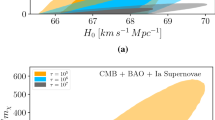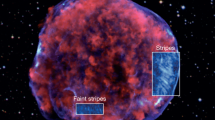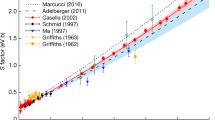Abstract
THE observed interstellar abundance of 2H has been used1,2 to estimate the mean baryon density (ρb) of the Universe. This follows, because (1) there is no plausible source for 2H other than the primordial big bang and (2) the production of 2H in a standard big bang decreases rapidly with increasing ρb. If one then assumes that all 2H was formed in a big bang, the observed abundance2 of this nuclide requires a value of ρb sufficiently low1 that, for a cosmological constant Λ = 0, the present expansion of the Universe will continue forever and the Universe is open. A major weakness in this argument is that another source of 2H may be found. It has been suggested, for example, that 2H could be made in shock waves accompanying a supernova explosion; this now seems unlikely3, but other mechanisms will certainly be suggested, so that it is important to obtain confirmation of the above conclusion. The predicted production of 7Li in a big bang2 varies rapidly with ρb and could be used to estimate ρb if the fraction of the observed 7Li made in the big bang were known. Unfortunately there are many possible sources4 of7 Li and such estimates must be regarded with scepticism. In this note we point out that 7Li can be used to place an upper limit on ρb, even if other production mechanisms are important, and that this limit also strongly favours an open universe. This possibility arises because the big bang production of 7Li increases with increasing ρb (for ρb>10−31) so that an upper limit is obtained by attributing all of the observed 7Li to the big bang.
This is a preview of subscription content, access via your institution
Access options
Subscribe to this journal
Receive 51 print issues and online access
$199.00 per year
only $3.90 per issue
Buy this article
- Purchase on SpringerLink
- Instant access to full article PDF
Prices may be subject to local taxes which are calculated during checkout
Similar content being viewed by others
References
Gott, J. R., Gunn, J. E., Schramm, D. N. & Tinsley, B. M. Astrophys. J. 194, 543–553 (1974).
Schramm, D. N. & Wagoner, R. V. A. Rev. nucl. Sci. (in the press).
Epstein, R., Arnett, W. D. & Schramm, D. N. Astrophys. J. Suppl. 31, 111–141 (1976).
Reeves, H. A. Rev. Astr. Astrophys. 12, 437–469 (1974).
Boesgaard, A. M. Pub. Astr. Soc. Pac. 88, 353–66 (1976).
Cameron, A. G. W. Space Sci. Rev. 15, 121–46 (1973).
Audouze, J. & Tinsley, B. M. Astrophys. J. 192, 487–500 (1974).
Wagoner, R. V. Astrophys. J. 179, 343–360 (1973).
Woody, D. P., Mather, J. C., Nishioka, N. S. & Richards, P. L. Phys. Rev. Lett. 34, 1036–1039 (1975).
York, D. G. & Rogerson, J. B. Jr Astrophys. J. 203, 378–385 (1976).
Tinsley, B. M. Phys. Today 30, 32–38 (1977).
Author information
Authors and Affiliations
Rights and permissions
About this article
Cite this article
AUSTIN, S., KING, C. A constraint on the universal baryon density from the abundance of 7Li. Nature 269, 782 (1977). https://doi.org/10.1038/269782a0
Received:
Accepted:
Issue date:
DOI: https://doi.org/10.1038/269782a0
This article is cited by
-
Lithium abundance at the formation of the Galaxy
Nature (1982)



